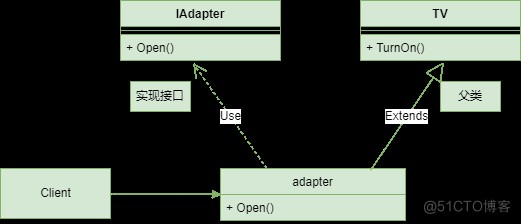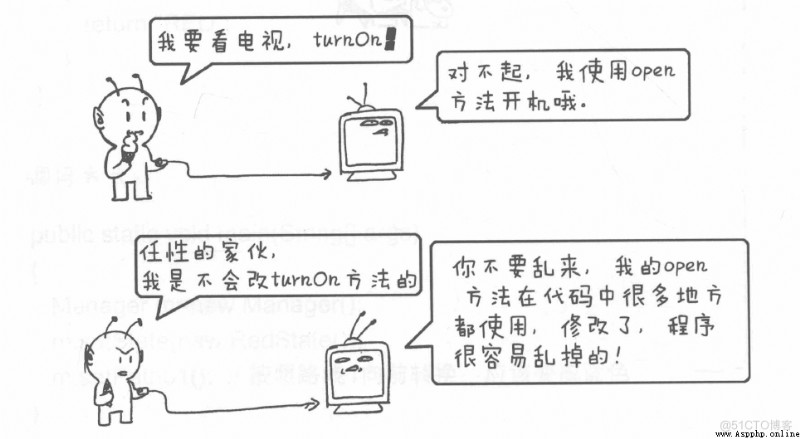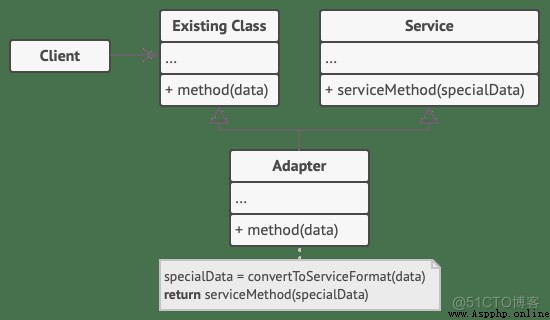Adapter pattern It's a kind of Structural type Design patterns , It enables objects with incompatible interfaces to cooperate with each other . adopt Combine Object to create new functions .
Adapter Help us make two incompatible interfaces compatible . What exactly does this mean ? If we have an old component , We want to use it in a new system , Or we want to use a new component in an old system . The two rarely communicate without modifying the code .
however , Changing the code is not always possible , Or because we can't access it , Or because it's unrealistic . under these circumstances , We can write an extra layer , Make some necessary modifications to the communication between the two interfaces , Communication between two interfaces .
This layer is called an adapter .
The adapter can not only convert data in different formats , It also facilitates cooperation between objects that use different interfaces . It works as follows :
Sometimes you can even create a bidirectional adapter to implement bidirectional conversion calls .
When our client Want to turn on the fan , And the fan provides turnOn Method , Call directly turnOn Enjoy the cool wind , For example, below :

Then it is the same open operation ,client Want to pass turnOn Call to turn on the TV , Television doesn't have this method , TV sets provide open Method .

If we just open Methods to turnOn Methods , It may cause a series of other problems in the system , At this time, we need our adapter mode .
Clients can use a variety of adapters , For convenience of storage , You can abstract out an interface for the adapter ,UML The graph is as follows :

Adapter (Adapter) Is a class that can interact with clients and services at the same time : It encapsulates the service object while implementing the client interface . The adapter accepts calls from the client through the adapter interface , And turn it into a call for the encapsulated service object .
The client code only needs to interact with the adapter through the interface , No need to couple with specific adapter classes . therefore , You can add new types of adapters to the program without modifying the existing code . This is useful when the interface of the service class is changed or replaced : You can create a new adapter class without modifying the client code .
The code is as follows :
public interface IAdapter {
public void turnOn(); // General boot function
}
public class Tv {
public void open() {
System.out.println(" The TV TV Turn it on , Only use open function ");
}
}
public class TvAdapter extends Tv implements IAdapter {
public void turnOn() {
super.open(); // Adapter pattern
}
}
Call mode :
public class Main {
public static void main(String[] args) {
IAdapter adapter = new TvAdapter();
adapter.turnOn();
}
}
This implementation uses an inheritance mechanism : The adapter inherits the interface of both objects . Please note that , This approach can only be implemented in programming languages that support multiple inheritance , for example C++.

class Target:
"""
The Target defines the domain-specific interface used by the client code.
"""
def request(self) -> str:
return "Target: The default target's behavior."
class Adaptee:
"""
The Adaptee contains some useful behavior, but its interface is incompatible
with the existing client code. The Adaptee needs some adaptation before the
client code can use it.
"""
def specific_request(self) -> str:
return ".eetpadA eht fo roivaheb laicepS"
class Adapter(Target, Adaptee):
"""
The Adapter makes the Adaptee's interface compatible with the Target's
interface via multiple inheritance.
"""
def request(self) -> str:
return f"Adapter: (TRANSLATED) {self.specific_request()[::-1]}"
def client_code(target: "Target") -> None:
"""
The client code supports all classes that follow the Target interface.
"""
print(target.request(), end="")
if __name__ == "__main__":
print("Client: I can work just fine with the Target objects:")
target = Target()
client_code(target)
print("\n")
adaptee = Adaptee()
print("Client: The Adaptee class has a weird interface. "
"See, I don't understand it:")
print(f"Adaptee: {adaptee.specific_request()}", end="\n\n")
print("Client: But I can work with it via the Adapter:")
adapter = Adapter()
client_code(adapter)
Run the program :
Client: I can work just fine with the Target objects:
Target: The default target's behavior.
Client: The Adaptee class has a weird interface. See, I don't understand it:
Adaptee: .eetpadA eht fo roivaheb laicepS
Client: But I can work with it via the Adapter:
Adapter: (TRANSLATED) Special behavior of the Adaptee.
advantage :
shortcoming :
Reference link :